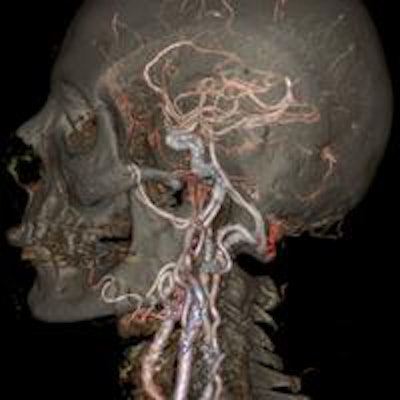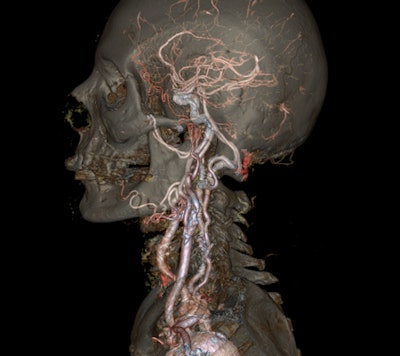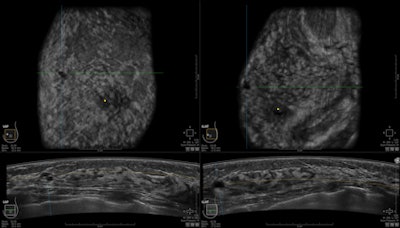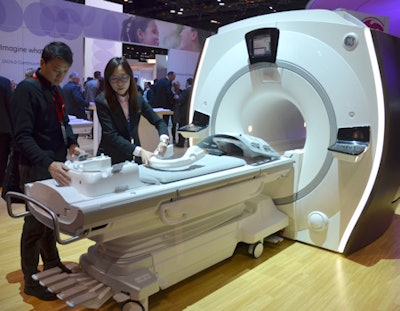
CHICAGO - A new CT scanner called Revolution that acquires 16 cm of data per rotation is the RSNA 2013 highlight for GE Healthcare. The vendor is also showcasing women's imaging, a rebranding of its automated breast ultrasound technology, and a new angiography system with large-format digital detectors.
CT
Revolution is a fundamentally new CT platform for GE that combines radiation dose reduction technologies with wider anatomic coverage. The company's previous CT technology had detectors that were 4-cm wide, giving Revolution a fourfold increase over the older technology, as well as improved temporal resolution.
The wider coverage is expected to produce a range of clinical benefits. The 16 cm of coverage is enough to cover most of the heart and chest with one gantry ration; CT scanners with narrower detectors would have to perform four rotations, with data stitched together to produce a single image.
 Image acquired with Revolution CT scanner demonstrates carotid arteries. Courtesy of GE.
Image acquired with Revolution CT scanner demonstrates carotid arteries. Courtesy of GE.Other Revolution advantages include a 0.28-sec gantry rotation speed and a bore size of 80 cm. Revolution's faster scanning speed also meshes well with GE software technologies such as SnapShot Freeze for reducing coronary motion, according to the company. Radiation dose is further reduced with technologies such as iterative reconstruction. The 256-detector-row scanner is capable of reconstructing data at 512 slices.
Revolution is pending 510(k) clearance from the U.S. Food and Drug Administration (FDA). The scanner was officially launched on Monday in a customer event featuring Jeffrey Immelt, GE's chairman and CEO, who ran the healthcare division until he was elevated to GE's top post in 2001.
GE is also touting its DoseWatch software for managing radiation dose. DoseWatch works with a variety of imaging modalities that use ionizing radiation, and it can be used to track and report radiation dose delivered to patients. It also provides alerts when dose exceeds defined thresholds, and it can provide dashboard looks at trends over time by different facilities.
For the Discovery CT750 HD scanner, GE is introducing kV Assist, which provides optimized personalized scanner settings and applications with automated kV and mA selection. The technique can be combined with SnapShot Assist for cardiac CT scans to provide improved image quality for lower dose.
GE is also promoting the Motion Freedom technique for its Optima CT660 Freedom Edition scanner. The mode includes "intelligent" correction for coronary motion and enables high-performance imaging with dose reduction features.
In other CT technologies, Adaptive Statistical Iterative Reconstruction (ASIR) V is the third generation of GE's dose reduction technology, which applies what GE has learned from its Veo model-based iterative reconstruction. The latter has good image quality and dose reduction characteristics, but it takes as long as 30 minutes to reconstruct an image that ASIR V reconstructs at real-time speeds, according to the company.
Another new feature is Discovery Gemstone Spectral Imaging (GSI), which offers better image quality at a lower dose for the Discovery 750 HD scanner.
Women's imaging
GE is highlighting its commitment to women's imaging with a special section of its RSNA booth, called Breast Cancer Connect. A key component of the exhibit is Invenia ABUS, the rebranded version of the automated breast ultrasound (ABUS) system the company acquired in its purchase of U-Systems last year.
Over the past year, GE has taken U-System's somo.v unit and made improvements to the technology, which is indicated as a supplemental screening option for women with dense breast tissue. Clinical documents filed with the FDA indicate that Invenia ABUS can improve breast cancer detection by 35.7% when used with mammography, compared with conventional mammography working alone.
 An image from GE's Invenia ABUS scanner, which the company is featuring at RSNA 2013.
An image from GE's Invenia ABUS scanner, which the company is featuring at RSNA 2013.GE notes that as of the RSNA meeting, 13 states in the U.S. require women to be notified of their breast density status; those with dense breast tissue can then be referred for an ABUS scan as a secondary screening test.
Also within the Breast Cancer Connect section is the company's SenoBright Contrast-Enhanced Spectral Mammography (CESM) protocol, which combines an iodine contrast agent with a protocol acquiring two images per view at different x-ray exposures. The images are then combined to highlight the contrast-enhanced areas.
Also on display is handheld breast ultrasound technology and advanced coils for breast MRI, as well as a "relaxing zone" as part of the company's SensorySuite concept for creating patient-friendly imaging environments. The zone demonstrates how breast screening environments can be made more relaxing for women, reducing anxiety, increasing patient satisfaction, and generating more referrals.
MRI
A big priority in the MRI section of GE's booth is the DV24.0 Continuum Pak, a new software upgrade available on the Optima MR450w, Optima MR450w with GEM, Discovery MR750, and Discovery MR750w with GEM.
DV24.0 includes Silent Scan, the vendor's MRI noise reduction technology that made a (quiet) splash at RSNA 2012. This year, the company is touting its success in expanding the number of clinical indications that use Silent Scan, such as a Silent Neuro package and a Silent Scan MR angiography feature that is pending FDA clearance. The company has shipped to 50 Silent Scan sites since last year.
 GE's Discovery MR750w system.
GE's Discovery MR750w system.The new upgrade package also includes productivity improvements of up to 30% compared with previous generations, due to workflow enhancements based on GE's new eXpress PreScan and Workflow 2.0 features. Other DV24.0 enhancements are designed to increase diagnostic confidence, such as a 3D imaging technique with real-time motion correction called Promo.
Meanwhile, Focus is a technique that provides high-resolution, organ-specific diffusion-weighted (DWI) and diffusion-tensor imaging (DTI) for small fields-of-view.
MAVRIC SL is also a part of the DV24.0 package; it is an MR scanning protocol that enables artifact-free imaging near metal implants. The technology was cleared in December 2012 and is showing its mettle in scanning around metal-on-metal hip implants.
GE is also discussing recent advances with MR-guided focused ultrasound. The company offers the technique in partnership with InSightec, which makes a focused ultrasound unit that runs on a GE MRI scanner. The technology currently has two clinical indications: treating uterine fibroids, and palliation of bone pain from metastasized bone tumors.
GE is also showing a dedicated MRI scanner for pediatric neonatal intensive care imaging as a work-in-progress concept. The tiny 3-tesla system is just big enough to scan a baby for applications such as neurological studies.
GE is planning to place the system on an investigational basis next year at two sites, which will evaluate the scanner and provide feedback to GE for further refinement. At the conference, the company is showing the system in a room with sticky notes for RSNA attendees to provide feedback on the technology.
Finally, GE is giving RSNA attendees a sneak peak at an important work-in-progress: a PET/MRI scanner with a ring of solid-state digital PET detectors integrated into an MRI gantry. The company's plan is to enable users of its Discovery MR 750w scanners to upgrade to hybrid technology when it becomes commercially available.
Molecular imaging
Q.Clear is a new iterative reconstruction algorithm that does for PET what iterative reconstruction has done for CT. The technique is applied to raw sinogram data, and GE believes that it produces more accurate measurements of standardized uptake values, which are becoming key for guiding treatment decisions.
Q.Clear is pending 510(k) clearance; the technology will be launched first on GE's Discovery 710 system, and then it will be moved to other scanners in GE's PET/CT product line.
On the workstation software side, Xeleris 3.1 is the newest version of GE's nuclear medicine workstation software. It includes features such as DaTquant, for quantitative analysis of SPECT images with GE's DaTscan ioflupane iodine-123 agent, and cardiac morphing, which enhances the visual clarity of cardiac images by reducing the blurring caused by cardiac contraction.
GE is also touting better access to Xeleris applications through the company's PACS and AW Server workstations, which should improve productivity and enable users to employ just one workstation. Xeleris also sports predefined and customizable autocapture and archive features to reduce redundancy from workflow.
Q.Suite is a package of tools designed to improve quantitative PET studies by generating more consistent readings of standardized uptake values, which can help clinicians assess a patient's response to therapy. Q.Suite includes improvements in daily quality control, scanner workflow, reconstruction algorithms, motion correction, and image analysis and reporting.
Healthcare IT
GE is shining the spotlight on Centricity 360, a cloud service that aims to facilitate real-time sharing of images with unaffiliated physicians and patients. Featuring a suite of on-demand imaging applications, Centricity 360 enables caregivers to exchange images and join private communities to collaborate on diagnosis and treatment discussions in near real-time, according to the vendor.
In addition, customers using Centricity PACS-IW software with the firm's Universal Viewer zero-footprint application can share a patient's case with one click from the PACS user interface, GE said. Centricity 360 can also run on any elastic cloud infrastructure, allowing radiology departments with third-party PACS to utilize cloud-based image archiving and sharing, according to the company.
Because all Centricity 360 applications and collaboration tools are provided via a cloud services platform, no upfront investment is required from clinical users, patients, or integrated delivery networks, GE said.
In other featured IT developments, GE said it has incorporated five advanced applications from its AW advanced visualization workstation into Universal Viewer.
Interventional radiology
GE is directing attention to its Discovery IGS 740 mobile x-ray angiography system at the RSNA meeting. Shown as a work-in-progress, IGS 740 is designed for interventional radiology applications and features a 41 x 41-cm detector, larger than the detector on the original Discovery IGS 730 unit, according to the vendor.
The unit employs a rails-free design to provide easy access to the patient, GE said. In addition, IGS 740 facilitates imaging of the anatomy of interest as well as full patient access from the left or right, the firm said.
GE believes that eliminating ceiling rails simplifies installation and offers flexibility for positioning ceiling-mounted ancillary components such as monitors, radiation shields, and lights. IGS 740 is currently pending FDA 510(k) clearance.
Ultrasound
After first showing automated breast ultrasound technology from its U-Systems acquisition at RSNA 2012, GE is presenting a next-generation ABUS unit this year. Invenia ABUS incorporates ultrasound technology from GE and adds advanced automation tools such as Compression Assist and Reverse Curve.
Invenia ABUS is half the size and twice as fast as the previous somo.v ABUS model, GE said. Commercial availability is expected in the first quarter. Pricing will run from $250,000 to $350,000, depending on configuration.
The vendor is also pointing to new image quality and workflow enhancement features on its Logiq S8 general-purpose scanner. A new suite of software and productivity tools brings enhanced scanning efficiency and improved imaging capabilities, while 10 new probes contribute more flexibility for a range of applications and patient types, GE said.
 Image from GE's Logiq S8 general-purpose scanner. Courtesy of GE.
Image from GE's Logiq S8 general-purpose scanner. Courtesy of GE.Compare Assistant allows clinicians to display DICOM-compatible images such as from ultrasound, mammography, CT, or MR studies directly on the ultrasound monitor before or during an exam to plan the scanning approach. Another tool, Power Assistant, provides system battery power during transport to decrease system shutdown and reboot time, while Scan Assistant significantly decreases keystrokes and shortens ultrasound exam time, GE said.
In other new S8 features, Breast Measure Assistant measures lesions with an autocontour tool, while OB Measure Assistant provides measurements during fetal measurement exams. GE has also added Breast and Thyroid Productivity Packages for automating the labeling, measuring, and description of lesions.
GE is also highlighting its flagship E9 with XDClear general imaging scanner, which was first introduced at the 2012 RSNA meeting.
In addition, GE executives are discussing how the company's ViewPoint ultrasound image management software has now been connected to the firm's new Centricity 360 cloud service and Universal Viewer zero-footprint image viewing application.
X-ray
GE is emphasizing recent research that suggests its VolumeRad radiographic tomosynthesis technology offers significant value in the detection and management of lung nodules.
In an international, multi-institution, multireader study being presented on Tuesday afternoon (SSJ06-01), VolumeRad was found to outperform conventional chest radiography by 3.6-fold for detecting nodules with a size range of 3 mm to 20 mm. In finding nodules 4 to 6 mm in size, VolumeRad yielded a 7.5-fold improvement.
The study also found that VolumeRad offered 1.5 times greater improvement in identifying cases that required follow-up with further imaging, without affecting specificity, GE reported.
In other x-ray highlights, the company is showing Konica Minolta's AeroDR cassette-size digital radiography (DR) retrofit offerings in its booth. GE inked a global distribution agreement for AeroDR in June.




















